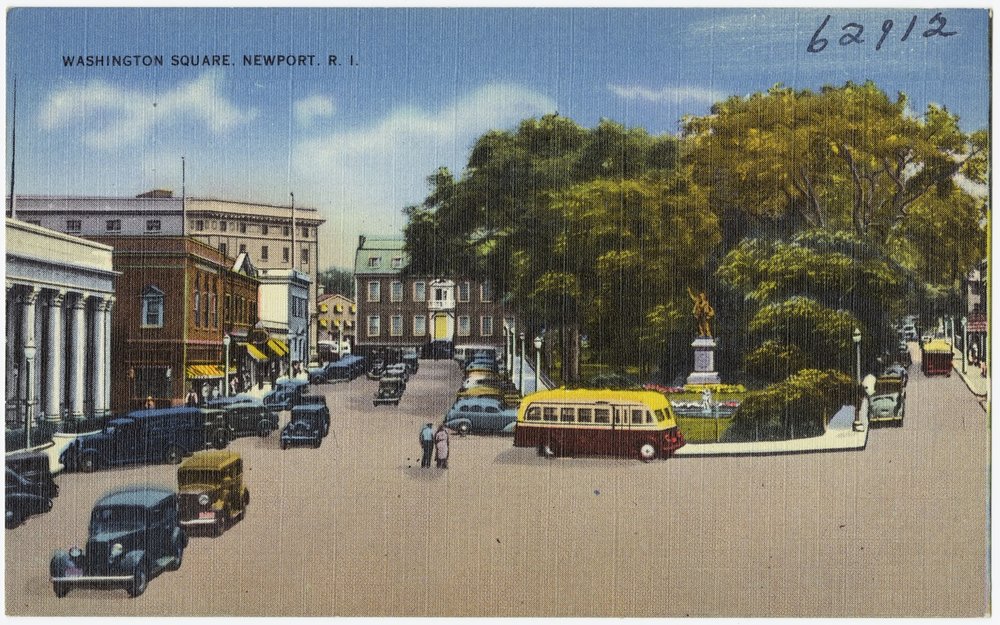Newport is a special place but sometimes it is easy for those who live here to forget just how special. In helping write the summary of the Washington Square Community Charrette report, based upon the Value Setting and Charrette process that more than three hundred people participated in last October, I was reminded how many National Register landmark historic assets are situated immediately around the park that was once the center of the Newport colonial settlement.
Individually listed National Register structures are the highest designation that is given by the Secretary of Interior and there are more than sixty of these in Newport alone – many of them in the single square mile of land surrounding Washington Square. This area has without question one of the greatest densities of National Register landmarks anywhere in the United States.
Among the very first buildings listed as part of the National Historic Register in 1966 as being central to American History when the National Historic Preservation Act (NHPA) was originally passed, were the Brick Market, the Old Colony House, the Redwood Library, the Wanton-Lyman-Hazard house, and the Touro Synagogue — all in the immediate vicinity of the Square. It is not an overstatement to say this area of Newport is one of America’s best-preserved colonial communities. These buildings are not simply part of the city’s history but they are central to the reason that people come to visit and live in Newport. Other places have harbors and urban areas where one can walk to shops and restaurants from attractive well-scaled residences, but there are few if any other places that have as rich a history or greater architectural authenticity as Newport offers. It is truly the Metropolitan Museum of Architecture — the place where some of the best works by the most important American architects of the 17th, 18th, 19th, and early 20th centuries were been built and preserved for posterity. And yet Newport is not a quaint historic village that has been “dipped in amber” to preserve it for all time without change. It is a city that has always balanced the preservation of the old with the construction of the new. That is how great buildings from four different centuries are able to sit side by side one another as good neighbors.
Newport recently welcomed Paul Carroll to the city staff as the new Director of Economic Development. The planning department, which once had three staff members, is in transition with all of them having left the staff within the last year. The city is currently looking to refill two of those positions with new personnel. It is important for the City Council and Newport’s citizens to encourage the City Manager and her staff that the city is not just a place to be “economically developed” but that preservation, high-quality design and the care that previous administrations have shown to the city’s physical assets are the very hallmark and foundation of the Newport “brand.” It is for these qualities that Newport is recognized around the world and they the reasons that nearly four million visitors come to Newport to see buildings, streetscapes, and architectural monuments they could see nowhere else.
And it is not just the treasured buildings that need care but every part of the city public works has an impact on the perception and therefore the value of experience. A modern street sign can irreparably damage a historic vista. Asphalt paving where once there were cobblestones can erode the sense of being in a place that existed before the time when cars ruled the urban landscape. Cobra headlights that look like they came from an interstate highway distort the scale and charm of a historic Broadway streetscape and do little to light the sidewalks where pedestrians might walk. For convenience’s sake, the current city policy of removing trees wherever they are surrounded by sidewalk diminishes the charm of the streets over time and makes them barren and empty. The small amount of additional time and care that is needed to take Newport beyond what is ordinary and normal to what is extraordinary and memorable is small and the cost is modest, but the payoff is enormous.
Historic assets, whether they be buildings or trees or sidewalks or light posts might exist for decades or centuries but can be lost in a moment of inattention or carelessness and can never be replaced or restored as well as the original. At every point we hope that our city leaders are asking themselves not “will this be easy and cheap?” but rather “will this be long lasting and valuable to both the residents and visitors?” If they use that measure as their guide and if capable, considerate, and caring planners are selected to fill the positions that are currently empty, Newport’s future will be every bit as bright as its rich and illustrious past. If you care about the special places and history that make Newport unique and valuable, please come to hear and see the conclusions of the Washington Square Charrette at a public presentation on May 1, 2013 at the First Baptist Church on Spring Street at 5:30 pm!
Looking to remodel your home? Let’s connect.
Join the Architectural Forum to stay up-to-date with architectural news from Rhode Island and abroad.
Ross Sinclair Cann, AIA, LEED AP, is a historian, urban planner, educator, and practicing architect living and working in Newport. This article was initially published in ARCHI-TEXT, in Newport This Week, April 25, 2013.
